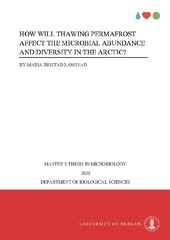How will thawing permafrost affect the microbial abundance and diversity in the Arctic?
Master thesis
Permanent lenke
https://hdl.handle.net/1956/23349Utgivelsesdato
2020-07-09Metadata
Vis full innførselSamlinger
- Master theses [258]
Sammendrag
Permafrost, permanently frozen soil, constitutes a major portion of the Earth’s terrestrial cryosphere and represents a unique niche for cold-adapted microorganisms. As the global temperature increases, it is still unknown what consequences this will have for the inhabiting microbial structure and diversity. We assessed the microbial diversity within permafrost in Adventdalen, Svalbard across two different years (2016 and 2019). Our results revealed that the living conditions of the indigenous microorganisms had changed, due to an increase in moisture and organic matter. Furthermore, we observed that the bacterial and fungal gene abundance had also increased. The majority of the microorganisms discovered within our samples are recognised as degraders of complex carbon compounds, indicating that a potential increase of carbon dioxide emissions is likely to be a consequence of the further increase in global temperatures. Due to differing study design across years, exact replicates were not possible, and most of the measured data would not be statistically reliable if compared directly to each other. However, one depth from each of the cores could be directly compared, and here we observed an overall increase in moisture content, organic matter, and in microbial abundance. We thus infer that there is a possibility of increased greenhouse gas release when the microbial living conditions have shifted.
